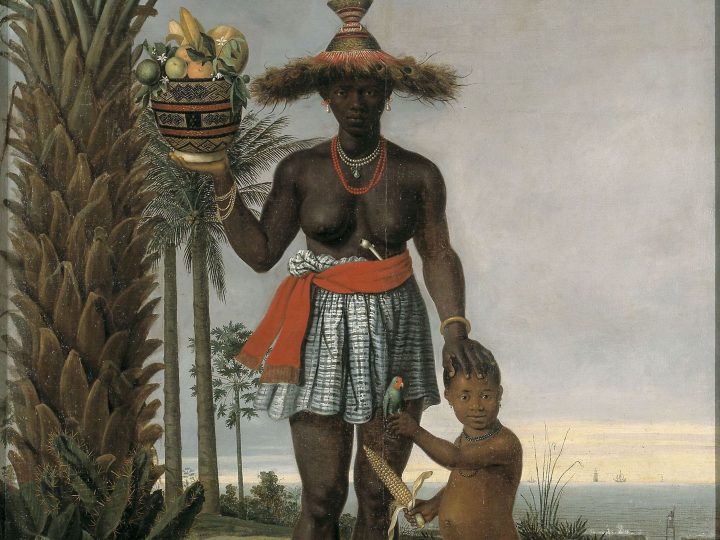We learn about works of art by attending to the material objects of everyday life. In her Self-Portrait in the National Gallery of Art, Judith Leyster holds a paintbrush. How does our perception of the painter and her portrait change when the handle of Leyster’s brush is found (by paintings conservator Laura Hartman) to be a porcupine quill so large that it must have come from Africa?
Likewise, the images we study as historians of Netherlandish art are rife with textiles and garments from around the world that are often overlooked. Albert Eckhout’s African Woman, from a series of four life-size pairs of Brazilian figures (Copenhagen), is emblematic of the complex, often fraught, interwoven circulation of goods, works of art, and people that, for a short time, centered on the Dutch. As an African brought to Brazil by the Portuguese or perhaps the Dutch, Eckhout’s woman, whether imagined or based on a real model, would have been enslaved. Her blue-and-white loom-patterned garment (like that of Eckhout’s African Man) would have carried associations of Africa—of home—for the people who wore such textiles. As readers of this issue will learn, this blue-and-white cloth—either from Africa or, more likely, made more cheaply in India and shipped by the Dutch in enormous quantities to Africa’s Guinea coast—would have had different associations for those who profited from the textile trade and the trade in human beings to which it was tied. Painted by a Dutch artist for Governor-General Johan Maurits van Nassau-Siegen, African Woman presents a sexualized, seen-through-European-eyes image of colonial life. Gifted by Johan Maurits to the king of Denmark after the Dutch lost Brazil in 1654, Eckhout’s African Woman sustained an image of Dutch primacy in world trade.
Textile Circulation in the Dutch Global Market, a special issue of the Journal of Historians of Netherlandish Art, aims to open our eyes to what textiles and garments, both real and represented, meant to the early modern people who used and wore them, understood their manufacture, regulated their value and points of origin, and recognized the rank and status they conferred more readily than we can today. This special issue also shows how textile research can foster exciting interdisciplinary conversations among art historians, historians, textile specialists, and scholars of material culture, among others. Guest editors Carrie Anderson and Marsely Kehoe introduce their collaborative digital art history Dutch Textile Trade Project and announce the launch of its open-access website (https://dutchtextiletrade.org), which makes available sources of the Dutch East and West India Companies, the VOC and WIC, from the years 1700–1724. In their opening article, “Textile Circulation in the Dutch Global Market: A Digital Approach,” Anderson and Kehoe introduce the project, its methods, and primary sources, and share preliminary findings. Next, four invited researchers in the field present case studies—on the textile trade within Asia; the common Madras kerchief; expensive, ready-made japonse zijde rokken; and the circulation of sits (chintz)—that draw from the data of the Dutch Textile Trade Project. Another two essays explore digital humanities topics related broadly to Dutch culture, looking at the New Netherlands Archive and the Montias Database.
JHNA managing editor Jennifer Henel has contributed two essays, one on the Dutch Textile Trade Project and the development of JHNA’s digital capabilities, and another on controlled vocabularies. We are enormously grateful to Jen for her outsized contribution to every aspect of the production of this issue.
Once again, we thank Jessica Skwire Routhier for her expert, attentive copyediting of the texts.
The research and travel for this special issue was funded by a grant from the Gladys Krieble Delmas Foundation; we owe special thanks to Jacquelyn N. Coutré and Alison Kettering for their role in securing these crucial funds. The Dutch Textile Trade Project has also been supported by two Samuel H. Kress Digital Art History Grants, and grants and technical support from Middlebury College’s MiddData.
We encourage you to consider publishing in JHNA, with its outstanding digital image capabilities. Moving forward from this issue, JHNA offers all authors the opportunity to connect their articles to the Getty Art and Architecture Thesaurus to further contextualize their scholarship and expand readership using a shared lexicon of cross-disciplinary efforts. With your help, JHNA will remain one of the leading journals for early modern art of the Netherlands and its region.
The journal welcomes submissions at any time. Please consult our Submission Guidelines.
H. Perry Chapman, University of Delaware, Editor in Chief
Jacquelyn N. Coutré, Art Institute of Chicago, Associate Editor
Bret L. Rothstein, Indiana University, Associate Editor
Joanna Woodall, The Courtauld Institute, Associate Editor
Alison M. Kettering, Carleton College, Past Editor in Chief
